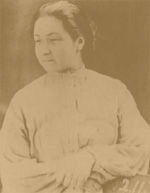|
Jealousy Does Dreadful Things

When the nursemaid, Elizabeth Gough, reported the child missing at 7.15am to Mrs Kent, a search commenced for the child,
who was found dead in an outside privy with his throat cut and a stab wound to the chest. There was no sign of blood in the
house, but the drawing room window had been found open despite the servants having closed it the night before.
The local magistrates soon became impatient for results from the local police Superintendent Foley's investigation, which
was largely directed towards the nursemaid Elizabeth Gough who had had responsibility for the child. They asked the Home Office
for assistance from Scotland Yard without the agreement of the local Chief Constable, and it was after a second request from
them that Detective Inspector Jonathan Whicher, then the most senior and well known of the detectives at Scotland Yard, was
sent.
Whicher concentrated on a missing night dress, possibly blood stained, belonging to Constance, and there was also circumstantial
evidence against her. The magistrates directed Constance's arrest and gave Whicher seven days to prepare a case. Mr Kent provided
a barrister for his daughter who dominated proceedings. Constance was released on bail and the case was later dropped. The
reaction in the newspapers was sympathetic to Constance, Whicher was heavily criticised, notwithstanding the difficulties
he had faced, and his reputation never recovered. The nightdress was never found and Whicher returned to London.
Five years later, in April 1865, after a period abroad and in a religious institution in Brighton, Constance attended
Bow Street magistrates court and confessed to the murder. Her motive had apparently been to exact revenge against the second
Mrs Kent for her treatment of Constance's mother. Constance was subsequently sentenced to death, but this was commuted to
20 years' penal servitude.
The confession from Constance came too late to save the career of Jonathan Whicher who
had been pensioned before Constance's appearance at Bow Street confirmed his original suspicion. It is a classic illustration
of how early investigations were directed heavily by magistrates, of the influence which well-to-do people could exert over
local police officers, and of the importance of immediately searching and questioning the whole household at the scene of
a crime, regardless of social status.
|
 |
|
 |
 |
Jonathan Whicher was one of the original members of the Detective Branch which had been established
at Scotland Yard in 1842. Jonathan 'Jack' Whicher was born in 1814 at Camberwell, London and died in 1881. After working as a labourer he joined the Metropolitan Police in 1837. He rose to the rank of Detective
Inspector and was renowned for his investigations. In 1860 he was called in to assist, along with Adolphus Williamson, the
investigation into the horrific murder of 4-year-old (Francis) Savile Kent. The child had been taken from the nursemaid's
bedroom at night and was found, with his throat cut, in an outside privy in the garden of his family's house the next morning.
The murder brought notoriety to the small village of Road (sometimes spelled Rode) in Wiltshire
|
|
 |
 |
 |
 |
|
Sophy Weller
Sophy Weller was an English prostitute. In 1837 she was spotted in a Gray's Inn Road brothel in London
wearing a stolen feather boa, by P.C Jonathan Whicher, who promptly arrested her and she was subsequently
tried and convicted for the theft, being transported as a consequence.
|
|
 |
 |
 |
 |
| |
|
|
|
Constance Kent and the Road murder
a page from the top music website
Musical Traditions
This website acts as a contact
point for those making
TV and
media enquiries about police
history,
especially on the subjects
of the
Metropolitan Police and Scotland
Yard.
A comprehensive history from 1829
to the present. in these pages you
will find descriptions of famous and
lesser known events throughout the
history of The Met as well as biographies
of key figures and details of famous cases
information on various aspects of
the history of the British Police
|
|
 |
 |
|
 |
|
|
 |
|
|
|

